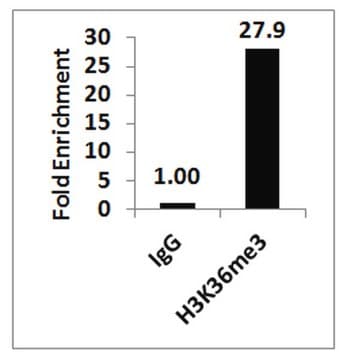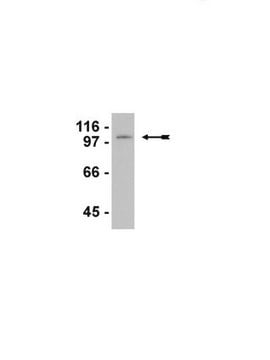17-10531
ChIPAb+ LSD1 (KDM1A) Antibody - ChIP Validated Antibody and Primer Set
from rabbit, purified by affinity chromatography
Sinónimos:
Lysine-specific histone demethylase 1A, BRAF35-HDAC complex protein BHC110, Flavin-containing amine oxidase domain-containing protein 2
About This Item
Productos recomendados
origen biológico
rabbit
Nivel de calidad
clon
polyclonal
purificado por
affinity chromatography
reactividad de especies
rat, human, mouse
fabricante / nombre comercial
ChIPAb+
Upstate®
técnicas
ChIP: suitable
immunoprecipitation (IP): suitable
western blot: suitable
Nº de acceso NCBI
Nº de acceso UniProt
Condiciones de envío
dry ice
Descripción general
The ChIPAb+ LSD1 (KDM1A) set includes a LSD1 antibody, a Normal rabbit IgG and positive control primers which amplify a 85bp human prostate-specific antigen enhancer region. The LSD1 antibody and negative control IgG are supplied in a scalable "per ChIP" reaction size and can be used to functionally validate the precipitation of LSD1 associated chromatin.
Inmunógeno
Aplicación
Sonicated chromatin prepared from hormone starved (72 hrs), then androgen agonist induced (1 µM CI-4AS-1 overnight) LNCaP cells (~1e5 cell equivalents per IP) were subjected to chromatin immunoprecipitation using 2 µg of either Normal Rabbit IgG (Part No. PP64B), or 2 µg Anti-LSD1 (Part No.CS207350) and the Magna ChIP HiSens (Cat. # 17-10460). Successful immunoprecipitation of LSD1 associated DNA fragments was verified by qPCR using ChIP Primers, PSA (Part No. CS207340) as a positive locus, and ChIP Primers, β-globin (Part No. CS200591) as a negative locus.
Please refer to the Magna ChIP HiSens (Cat. # 17-10460) or EZ-Magna ChIP HiSens(Cat. # 17-10461) protocol for experimental details.
Chromatin Immunoprecipitation:
Sonicated chromatin prepared from hormone starved (72 hrs), then androgen agonist induced (1 µM CI-4AS-1 overnight) LNCaP cells (1e5 and 1e6 cell equivalents per IP) were subjected to chromatin immunoprecipitation using 2 µg of either Normal Rabbit IgG (Part No. PP64B), or 2 µg Anti-LSD1 (Part No. CS207350) and the Magna ChIP HiSens Kit (Cat. # 17-10460). Successful immunoprecipitation of LSD1 associated DNA fragments was verified by qPCR using ChIP Primers, PSA (Part No. CS207340).
Please refer to the Magna ChIP HiSens (Cat. # 17-10460) or EZ-MagnaChIP HiSens (Cat. # 17-10461) protocol for experimental details
Western Blotting Analysis:
HeLa nuclear extract was probed with Anti-LSD1 (0.05 μg/mL).
Proteins were visualized using a Donkey Anti-Rabbit IgG secondary antibody conjugated to HRP and a chemiluminescence detection system.
Epigenetics & Nuclear Function
Histones
Envase
Calidad
Please refer to the MagnaChIP HiSens (Cat. # 17-10460) or EZ-MagnaChIP HiSens (Cat. # 17-10461) protocol for experimental details.
Descripción de destino
Forma física
Normal rabbit IgG, Part No. PP64B. One vial containing 125 µg Rabbit IgG in 125 µL storage buffer containing 0.05% sodium azide. Store at -20°C.
ChIP Primers, PSA. Part No. CS207340. One vial containing 75 μL of 5 μM of each primer specific for human prostate-specific antigen (PSA) enhancer region (chr19:51354179-51354263, hg19 build). Store at -20°C.
FOR: GCC TGG ATC TGA GAG AGA TAT CAT C
REV: ACA CCT TTT TTT TTC TGG ATT GTT G
Almacenamiento y estabilidad
Nota de análisis
Includes normal rabbit IgG and primers specific for a human prostate-specific antigen (PSA) enhancer region.
Otras notas
Información legal
Cláusula de descargo de responsabilidad
Código de clase de almacenamiento
10 - Combustible liquids
Certificados de análisis (COA)
Busque Certificados de análisis (COA) introduciendo el número de lote del producto. Los números de lote se encuentran en la etiqueta del producto después de las palabras «Lot» o «Batch»
¿Ya tiene este producto?
Encuentre la documentación para los productos que ha comprado recientemente en la Biblioteca de documentos.
Nuestro equipo de científicos tiene experiencia en todas las áreas de investigación: Ciencias de la vida, Ciencia de los materiales, Síntesis química, Cromatografía, Analítica y muchas otras.
Póngase en contacto con el Servicio técnico







